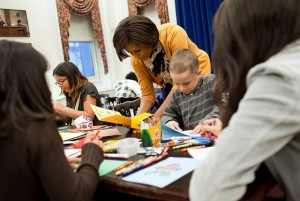Greeting Card Assembly Line

Lesson created by Heather Krey of Kutztown University. It won the 2013 American Association of University Women’s “Engineer a Lesson” contest. Click HERE for PDF
Summary
In this collaborative math and art lesson, students in grades 4 through high school explore central ideas in industrial engineering – including productivity, efficiency, and quality – by designing their own assembly line and working together to mass produce greeting cards.
Note: This is meant to be team taught with an art and math teacher, but if just one teacher is available, a parent volunteer could help out.
Grade level: 4th and 5th but can be adapted for high school students.
Time: 1.5 – 2 hours
Learning Objectives
After doing this lesson, students will be able to:
- Use art materials to create a greeting card based on a predetermined design
- Work together to design an assembly line
- Evaluate and improve the assembly line
- Understand the definitions in the vocabulary list
- Develop an appreciation for the profession of industrial engineering
Essential Question: How can we produce greeting cards as efficiently as possible without sacrificing quality?
Standards
Common Core State Mathematics Standards
Standards for Mathematical Practice: 1. Make sense of problems and persevere in solving them Standard for Mathematical Practice: 4. Model with mathematics Standard for Mathematical Practice: 5. Use appropriate tools strategically.
Grade 5 Standards: Number and Operations in Base Ten Cluster:
- Perform operations with multi-digit whole numbers and with decimals to hundredths.
- Standard: 6. Find whole-number quotients of whole numbers.
- Domain: Measurement and Data 4 Cluster: Represent and interpret data.
- 2. Make a line plot to display a data set of measurements in fractions of a unit (1/2, 1/4, 1/8). Use operations on fractions for this grade to solve problems involving information presented in line plots.
Materials
- Whiteboard & markers
- Stopwatches
- Sample greeting card
- 7 Posters
- 12 Small signs with Velcro (or large Post-It notes) that can be affixed to poster
- 2 bins or boxes labeled “pass” and “fail”
- Card making materials (card stock, scissors, glue, etc.) for each student to make about ten cards
Pre-Class Preparation
Seven large signs should be created that read Warehouse, Quality Control, Workstation 1, Workstation 2, Workstation 3, Workstation 4, and Repair Shop.
The art teacher should design a greeting card that takes several steps to create, as it will need to be produced in an assembly line. This could be a thank you, happy birthday, or any other type of greeting card. The design should incorporate the school’s name and be appropriate for the season.
The teachers should break down the card making process into about 12 steps and prepare small signs for each individual step. These signs should either have Velcro on the back or simply be written on postit notes so that they can be affixed to the workstation signs by the students.
The room should be set up so that each student will have individual work space, but flexibly enough that the students can work in groups later in the lesson. There should also be areas designated as the warehouse (where the materials will be located) and quality control (where the pass and fail bins will be located).
Instructional Procedure 
Introduction (5 minutes) Both teachers welcome the students to class and tells them they are going to be industrial engineers today. The math teacher explains that there are many kinds of engineers. For instance, civil engineers design roads and bridges, mechanical engineers design things with moving parts like machines, and computer engineers design computers. Industrial engineers, on the other hand, do not design products but figure out how to build them correctly and efficiently. In other words, a mechanical engineer might come up with the design for a new car, and then an industrial engineer will figure out how to produce 10,000 of those cars in a factory.
Photo: First Lady Michelle Obama looks at holiday cards being made for active duty service members at a Nov. 29, 2010 mentoring event.
Demonstration (5 minutes) The art teacher explains that the product we will be building today is a greeting card. She shows the students a card she has already designed and then “builds” a new card, describing each step as she goes. As the art teacher is demonstrating the steps, the math teacher should bring the pre-prepared sign for each step into view.
Trial One (10 minutes) The students are then instructed that they will have 10 minutes to make as many cards as possible, each working individually. The math teacher, taking on the role of supervisor, sets a timer for 10 minutes and tells the students to START. At that point, each student may gather materials from the warehouse and begin constructing cards. Each time a card is completed, the student must hand it to the art teacher, who takes the role of quality control and sorts the cards into the pass and fail bins. After 10 minutes, the math teacher calls “STOP” and all production must cease.
Discussion One (5 minutes) The art teacher counts how many cards are in each bin and writes the results on the whiteboard. The math teacher leads a discussion in which the concepts of productivity, efficiency, and quality are introduced. She draws the three charts on the whiteboard (see figure), entering the data from Trial One. The productivity is the total number of cards is the pass bin. The efficiency is the productivity divided by 10 (since it was a 10 minute trial). The quality is the total number of cards passed divided by the total number of cards made, expressed as a percent.
Line Balancing (10-25 minutes) Students are then asked if they have any ideas as to how they could work more efficiently. If the students do not come up with the idea themselves, the teacher should suggest that they work as an assembly line. She will direct their attention to the small signs with each task and provide them with the large signs for the workstations. If time permits, students should work together using stopwatches to determine how much time it takes to complete each individual task.
Using this data (or their best guess, if the timing step was skipped) the students should decide which tasks should 0 5 10 15 20 25 Trial 1 Trial 2 Trial 3 Trial 4 Productivity (Cards Made) 0.0 0.5 1.0 1.5 2.0 2.5 3.0 Trial 1 Trial 2 Trial 3 Trial 4 Efficiency (Cards Per Min) 50 55 60 65 70 75 80 85 90 95 100 Trial 1 Trial 2 Trial 3 Trial 4 Quality (Percent Passed) 7 be done at which stations, and affix the correct steps to each workstation sign. The teacher will tell the students that distributing the tasks so that the total time for each workstation is approximately equal is called line balancing. They should also organize themselves as the workers at the various stations and move the materials from the central warehouse to the point where they will be needed in the assembly line. They may also place their partially completed cards in the correct workstations to be finished by the assembly line.
Trial Two (10 Minutes) When the students are ready, the math teacher says “START” and gives the students 10 minutes to produce as many cards as possible working as an assembly line. Each card should be inspected by quality control and placed into either the pass or fail bin. Discussion Two (15 Minutes) At the end of Trial Two, the art teacher counts the cards in the pass and fail bins, and the three charts are updated accordingly. The math teacher leads a discussion where the students brainstorm ways in which their efficiency could be improved even more. The teacher should use this discussion to introduce the term bottleneck as the workstation that takes the longest time. The students should identify which workstation is the bottleneck, and decide if one of its tasks should be moved to a different workstation or if more workers should be assigned to the bottleneck workstation. They should also identify the workstation with the most idle time, and make appropriate changes. Finally, students should be invited to create a new workstation, the repair shop, which fixes cards in the fail bin and resubmits them to quality control.
Trial Three (10 minutes) When the students have completed their improvements to the assembly line, the math teacher says “START” and gives the students 10 minutes to once again produce as many cards as possible. At the end of the 10 minutes, the cards in the pass bin are counted and the productivity, efficiency, and quality charts are updated. If time permits, the students may be given the opportunity to make more improvements and complete a Trial Four.
Closing (15 minutes) Students should already be organized into their groups according to their workstation. One of the teachers leads a short discussion where the students are given a chance to discuss what they learned in this activity. The teacher also asks them to think of examples of products that are probably produced on an assembly line. Finally, student groups work together to complete the matching exercise.
Follow Up At a later time, the students may vote on what to do with all the cards they have produced. For instance, they may each take some home for personal use, they may give the cards to school staff on Teacher Appreciation Day, or they can sell the cards as a fundraiser.
Assessment
See quiz on page 12-14 of PDF.
Adaptations for older students
This lesson is designed for the fifth grade, but it could certainly appeal to older students as well. Older students can produce more complex cards and will need less guidance from the teacher to complete the activities. For instance, instead of breaking the process down into several smaller tasks, the teacher should allow the students to do that on their own. Furthermore, the quality control standards can be higher for older students. High school students may benefit from watching the video on Line Balancing before designing their assembly line.
Additional resources
Line Balancing video
Card Making Assembly Line video
Assembly Line Card-making ClubScrap.com how-to lesson for turning 6 A2-sized pieces of paper into nine cards. [YouTube 4:51]
Build a Pop-Up Card PBS Kids’ Design Squad Nation activity
Filed under: Class Activities, Grades 6-8, Grades 6-8, Grades 9-12, Grades 9-12, Grades K-5, Grades K-5, Lesson Plans
Tags: Art, assembly line, Class Activities, Common Core State Mathematics Standards, girls in STEM, Grades 6-8, Grades 9-12, Grades K-5, greeting card, Industrial engineering, Lesson Plans, Math, STEAM








